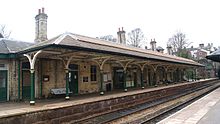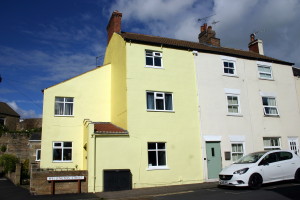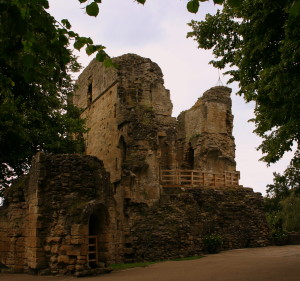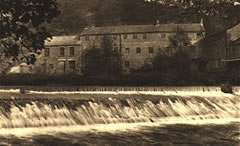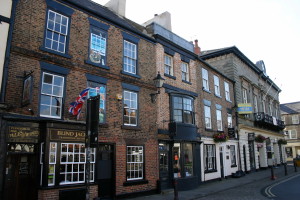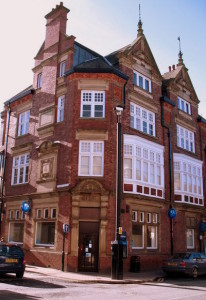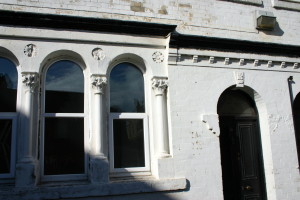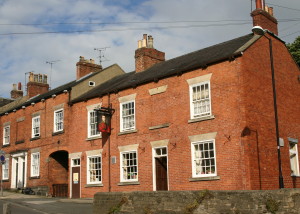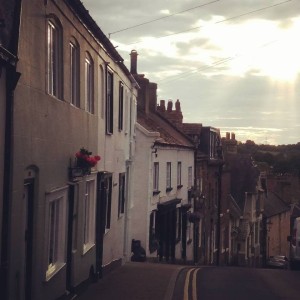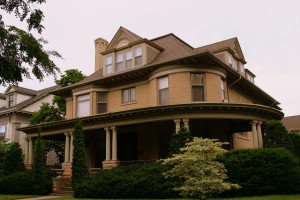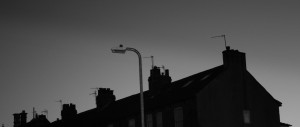
Welcome to the
Healy Project
Join us on Facebook
Send us an Email
Henry Ingham’s Yorkshire

British Railways Riddles ‘Standard’ 9F 2-10-0 locomotive number 92220 EVENING STAR of York MPD crosses Knaresborough Viaduct. Wikimedia
I have always admired the work of Henry Ingham, a native of Knaresborough, Yorkshire, and one of Minneapolis’s “Big Three” master builders. But I never thought about visiting Knaresborough until I met a woman from Durham, England, on a 2014 trip to Norway. “Oh, you must visit Knaresborough,” she exclaimed. “It’s one of the most historic, quaint, and beautiful cities in North Yorkshire.” And so, last spring I planned a visit. (For a brief bio of Ingham, see http://healyproject.org/more-hauntings-houses-built-by-henry-ingham/).
In July I flew into Manchester, then took the train to Knaresborough, changing trains in Leeds. The train pulled into the charming old station, and I crossed the tracks and started up the very steep hill to my B&B. I had hoped to meet with local architectural historians, but my inquiries from the ‘States weren’t answered. However, as luck would have it, as I walked around town later that afternoon looking for Wellington Street, the 1861 and 1871 addresses of the Ingham family, I came upon some locals having a brew outside the pub. One of them kindly took me to the home of David Druett, a local historian who lives just around the corner from Wellington Street. From him I learned that only a few of the old houses on Wellington Street remain. It’s likely that the Inghams’ residences at #69 and #110 on that street were demolished for a post-WWII government housing project. Druett said that the three remaining old houses are workers’ houses from the 1840s, constructed cheaply (for that time), with relatively thin walls.
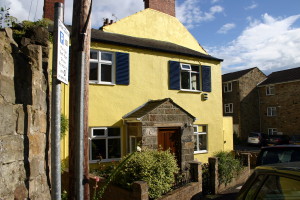
The front of David’s house on Brewerton Street with the postwar housing projects visible across Wellington Street.
It was a disappointment to find the two Ingham residences gone, along with most of old Wellington Street, so I turned my attention to what does remain in Knaresborough. What kind of influences on Ingham’s designs might I find?
Needless to say, the history of Knaresborough, an old market town, goes way back into antiquity. The first recorded mention of Knaresborough is in the Domesday Book, 1086. The Normans built a fortified castle on the bluff overlooking the River Nidd in the 1100s. The ruins of the 14th century castle, built by King Edward II, still remain. The castle was not ravaged by time, however, but by the Parliamentarians during the (English) Civil War. In 1648 demolition of the Royalists’ castle complex began. It would have been totally wrecked if the townspeople hadn’t petitioned to leave the King’s Tower remaining for use as a prison.
In the 19th and early 20th centuries Knaresborough’s economic base was the textile industry. The linen mill on the river began operating in 1791. “The structure might previously have been used as a paper mill, and adapted to new use shortly after November 1790 when a new water wheel was planned. Castle Mills was converted to flax spinning for linen in 1811 and Walton and Company leased it in 1847 for yarn spinning and power loom weaving, which took place in other buildings on the site. Linen production ceased in 1972 and Walton left the site in 1984.” [–from the designation of the Castle Mill building as a listed historic site].
Yorkshire was an industrial area throughout the Victorian period, known for its textile mills (linen, cotton, wool) large and small. In keeping with its new prosperity and importance, Yorkshire’s civic and institutional buildings were designed to impress. They’re massive and imposing, built of durable brick or stone.
While many pre-1900 cottages and houses were demolished during periods of “urban removal” through the centuries, many remain. Of course, I was primarily interested in the buildings from the mid- to late-nineteenth century. Knaresborough’s Victorian houses have primarily stone or stucco exteriors. I discovered that some of the remaining mid-century buildings are embellished with the Neo-Classical ornaments that Ingham loved.
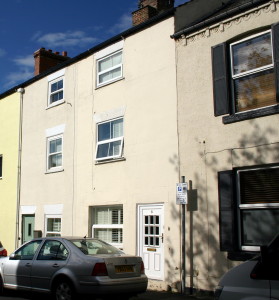
The three houses remaining on Wellington Street built in the 1840s. Note the ornamental cornice on the one at right.
Here are some photos of typical Victorian buildings in Knaresborough:

The Primitive Methodist Chapel, built 1851, (now apartments) in the courtyard behind the Wellington Street houses.
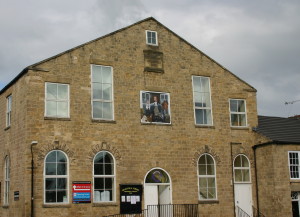
The Gracious Street Methodist Church Hall, with image of John Wesley. Wesley, the founder of Methodism, visited Knaresborough a number of times and left his mark on the town. The inghams were Methodists, as was the other Minneapolis master builder from West Yorkshire, Henry Parsons.
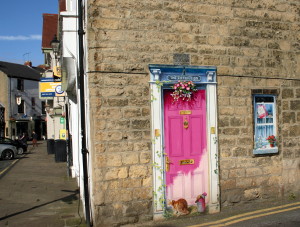
Playful contemporary trompe l’oeil (fool the eye) painted door and window on the side of an old building on Market Place.
This is just a guess, but young Henry Ingham must have seen that there were not many opportunities for making a career as a master carpenter or builder of wood frame houses in North Yorkshire. Sometime between 1871 and Thomas Ingham’s death in 1881, the family moved to the industrial city of Bradford, West Yorkshire. Armed with his certification as a master carpenter and joiner, in 1883 Henry Ingham, accompanied by his brother Alfred, lit off for the prairie boom town of Minneapolis. There in 1884 the Inghams built their first house at 3020 First Avenue South (wrecked in 1963 for freeway construction, as were so many of Healy’s houses).
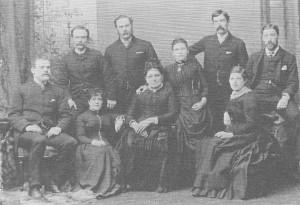
Thomas Ingham family after his funeral, Bradford, Yorkshire, 1881. Henry standing at far left, back row.
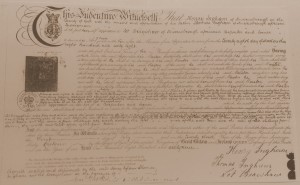
Henry Ingham’s papers of indenture as apprentice to Lot Brayshaw, carpenter and joiner of Knaresborough, 23 July 1868.
In 1890, Henry began designing and building houses on his own, and Alfred’s name disappears from the building permits. In his long career, 1884-1913, Henry built over 120 structures, including houses, apartment buildings, barns, and architect-designed residences. The interiors of his houses show exquisite craftsmanship in the millwork and cabinetry; the exteriors have a classical, understated grace. Yorkshire’s loss was Minnesota’s gain. In turn-of-the-century Minneapolis, master carpenter-builder Henry Ingham found his métier.
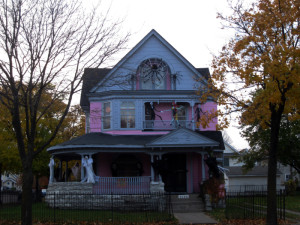
3146 Portland Ave. S. 1892, $6.000. The “Pink Ingham.” A flamboyant Ingham transitional Queen Anne, decked out for Halloween. (Photo by Madeline Douglass)
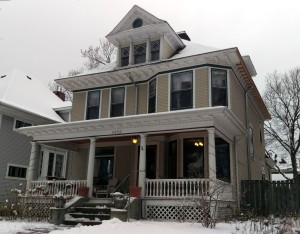
2432 Bryant Ave. S. 1899, $3,200. Ingham built this for Emma Goetzenberger, who apparently had excellent taste in builders. Healy and Purcell also designed and built houses for her in the Wedge.
+++++++++++++++++++
Many thanks to Kathy Kullberg and Ezra Gray for researching the Ingham family in Yorkshire. Thanks also to David Druett for giving me a glimpse into Victorian Knaresborough.
Ingham building research by Anders Christensen.
Photos without source noted are by Trilby Busch. Please credit if you reuse.
The Healy Project is planning a tour of Ingham houses in the not-too-distant future. Watch this blog for notices.
–T.B.
